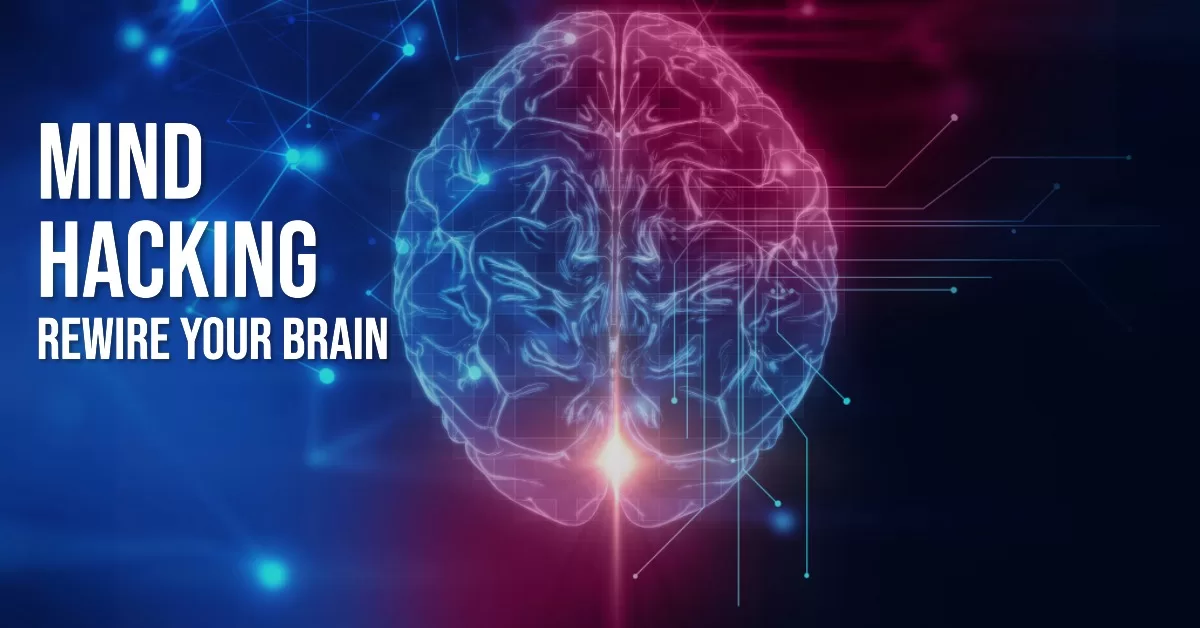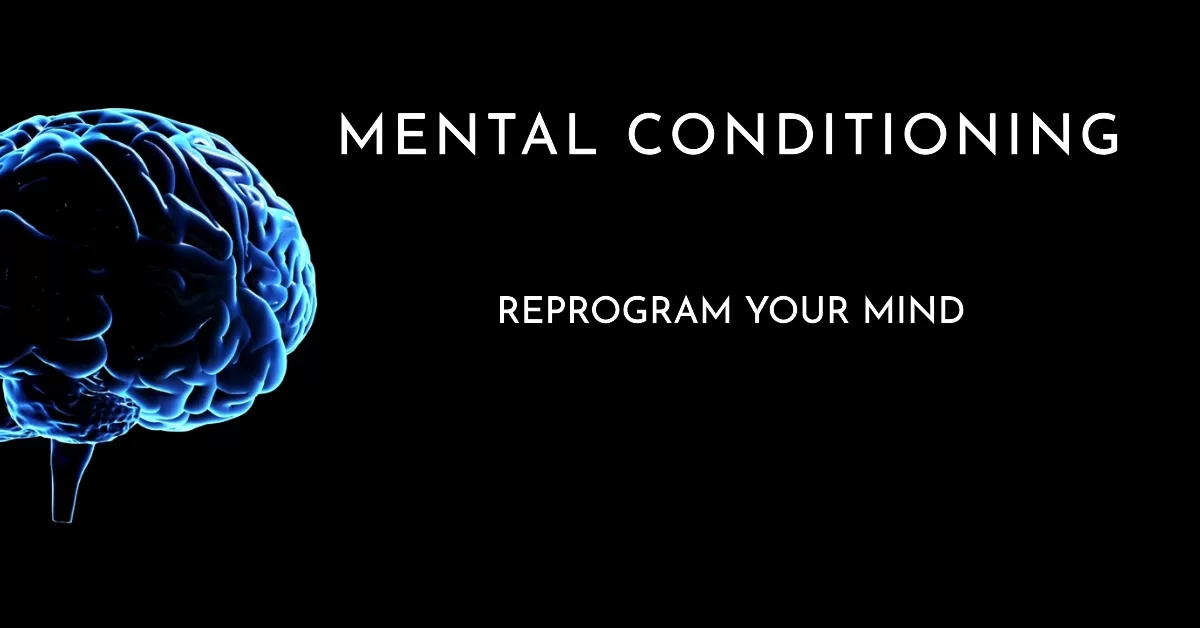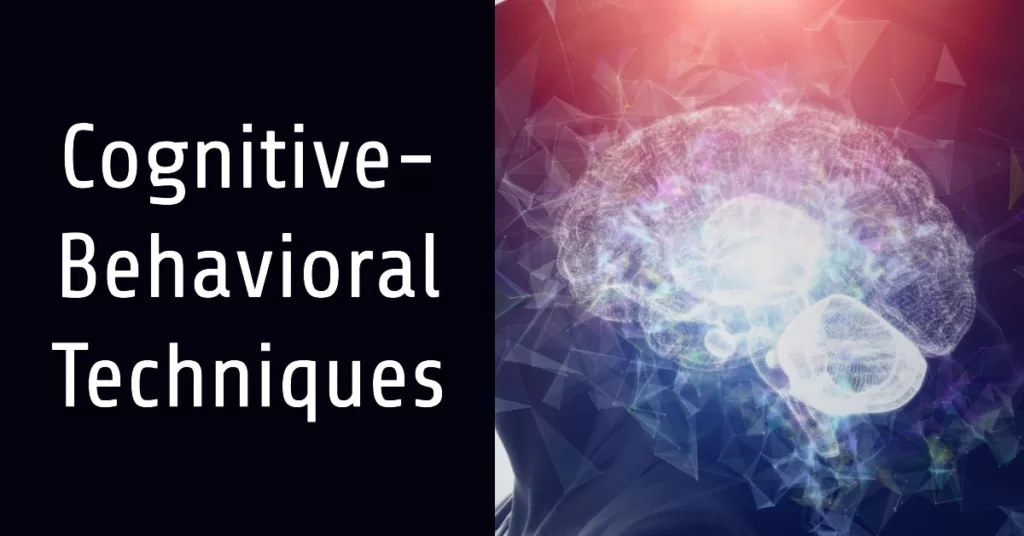Cognitive-behavioral techniques (CBTs) are a set of strategies used to help individuals develop and maintain positive mental health. CBTs are based on the idea that our thoughts, feelings, and behaviors are interconnected and can influence one another. Through cognitive restructuring, reality testing, relaxation techniques, mindfulness, exposure therapy, behavioral activation, and self-monitoring individuals can learn to modify their thoughts and behavior in order to improve their mental condition. This article will provide an overview of CBTs in mental conditioning.
The purpose of CBTs is to identify patterns in maladaptive behaviors and thinking that may be exacerbating negative emotions or disrupting positive functioning. It involves helping the individual become aware of their automatic responses to certain situations so they can alter them over time. By learning how to manage their own thoughts and actions more effectively people can make lasting changes in their life that promote better mental health outcomes. Furthermore, by developing healthier coping mechanisms people can build resilience against stressors such as anxiety or depression. This article will discuss the various approaches involved with CBTs as tools in mental conditioning.
Table of Contents
Overview of Cognitive-Behavioral Techniques
Through various scientifically-backed methods, individuals can learn to modify their reactions and attitudes to gain greater control over their lives. Cognitive-behavioral techniques are among the most widely used approaches in modern psychology and rely on the concept of ‘cognitive restructuring’ – i.e., changing the way one thinks about a particular issue or problem. This is done by identifying patterns of thinking that lead to unhealthy behaviors, such as negative self-talk or avoidance strategies, and replacing them with more productive thoughts. The goal is to create an internal dialogue that helps an individual better manage difficult emotions or stressful situations without resorting to maladaptive coping mechanisms like substance abuse or neglecting responsibilities.
The principles behind cognitive-behavioral techniques are largely based on the idea that our thoughts influence our behavior, and vice versa. By understanding how these two elements interact with one another, people can begin to identify which thoughts lead to certain behaviors and how they might be able to change those behaviors in order to achieve positive outcomes. Cognitive-behavioral interventions typically involve activities such as creating thought records (i.e., writing down one’s thoughts before and after engaging in a particular behavior) as well as learning relaxation exercises designed to reduce stress and anxiety levels so that individuals can think more clearly when faced with difficult decisions or emotions.
Cognitive-behavioral techniques also focus on developing healthier behaviors through positive reinforcement strategies; rewards for engaging in desired behaviors serve as motivation for future engagement in those same activities. Additionally, this approach includes exploring effective communication skills such as active listening and assertiveness training in order to foster healthy relationships within families or other social circles while teaching people how best to handle confrontation without becoming overwhelmed by it emotionally or physically lashing out at others due to frustration or anger issues which often arise from unresolved conflicts between parties involved.
Finally, cognitive-behavioral techniques also encourage individuals to take ownership of their own mental health habits by setting realistic goals for themselves – this involves breaking larger objectives into smaller achievable tasks while recognizing progress along the way rather than only focusing on results achieved once everything has been accomplished at once. With practice, individuals can gradually begin taking more responsibility for managing their mental health while developing healthier coping mechanisms through cognitive restructuring processes so they may become better equipped at responding appropriately during times of distress rather than resorting back toward old unhelpful habits which may have led them astray priorly from where they wished themselves mentally/physically speaking – leading them toward greater long term success both personally & professionally within society’s scope overall & beyond moving forward optimistically!
Cognitive Restructuring
Cognitive restructuring is a type of cognitive-behavioral technique used to challenge and modify unhelpful thoughts. It serves to identify cognitive distortions, which are the irrational or distorted ways of thinking that can lead to negative emotions and behaviors, and replace them with more balanced thinking. Through cognitive restructuring, individuals can learn to recognize their own patterns of thought in order to create positive changes in their behavior and outlook on life.
Challenging Unhelpful Thoughts
Identifying and replacing unhelpful thoughts can be an effective way to address underlying issues. Challenging unhelpful thoughts is a cognitive-behavioral technique used in mental conditioning, which involves challenging the accuracy of one’s own negative thoughts. This technique requires the person to become aware of their thinking patterns and recognize when they are having distorted or irrational beliefs about themselves and their environment. Through this process, individuals are able to replace these negative thought patterns with more balanced and beneficial ones.
There are several different approaches for challenging unhelpful thoughts; such as asking questions, slowing down thinking processes, reframing situations from a different perspective, using humor or distraction techniques, generating alternative solutions, and creating action plans. It is important for those practicing this technique to remember that it is not possible to completely eliminate all unhelpful thoughts but rather learn how to effectively manage them in order to increase wellbeing.
Identifying Cognitive Distortions
Understanding cognitive distortions is an important part of challenging unhelpful thoughts. Cognitive distortions are forms of biased thinking, including overgeneralizing, personalizing, catastrophizing, and all-or-nothing thinking. These patterns of distorted thought can lead to lower self-esteem and depression if left unchecked.
Cognitive distortions occur when a person makes generalizations about themselves or the world that may not be accurate. For example, a person might assume they have failed at something because they are ‘stupid’ rather than recognizing that failure can happen to anyone regardless of intelligence level. People also often make faulty assumptions about how others perceive them; assuming people are judging them negatively without any evidence to support this assumption. Additionally, people can distort reality by imagining worst-case scenarios as if they were certainties instead of possibilities. Finally, some will adopt an all-or-nothing mentality; believing they must be perfect in order for their efforts to count for anything at all.
These common cognitive distortions can be identified and challenged with mental conditioning techniques such as mindfulness meditation and cognitive behavioral therapy (CBT). To challenge these biases, one must first recognize when these patterns are occurring, then question the accuracy of the thought process behind it and look for alternative interpretations that better reflect reality. Through practice and effort over time, these more realistic thoughts can become stronger than the initial biases leading to improved wellbeing overall.
Creating More Balanced Thinking
Creating balanced thinking involves recognizing and challenging cognitive distortions to replace them with more realistic interpretations of events. This process requires a person to identify irrational thoughts, analyze their accuracy, reflect on the validity of those thoughts, and then arrive at a more objective thought pattern. An effective technique for doing this is called ‘cognitive restructuring’ which involves changing maladaptive thought patterns into healthier ones by considering different perspectives. The goal is to recognize internal biases that lead to distorted thinking and then consciously choose an alternative perspective that is based on evidence and facts rather than emotional reactions or preconceived notions. On top of that, self-monitoring one’s own behavior can be helpful in understanding the root causes of negative emotions so that they can be addressed effectively in order to create more balanced thinking.
Reality Testing
Reality testing seeks to assess the validity of thoughts and beliefs in order to promote rational decision-making. It is a cognitive-behavioral technique that involves examining one’s beliefs and assumptions by comparing them with observable reality, thereby allowing for more accurate interpretations of events. Reality testing helps individuals to develop greater awareness about their own thinking patterns, as well as how they interact with their environment.
The goal of reality testing is to determine whether a thought or belief corresponds with the actual state of affairs. Through this process, individuals can learn to identify irrational thinking patterns that lead to maladaptive behaviors. This allows them to modify these patterns in order for them to produce better outcomes when making decisions or responding to stressful situations.
In reality testing, it is important for individuals to be mindful of their thoughts and feelings in order to evaluate the validity of their beliefs and interpretations accurately. It also requires an open mind so as not to be influenced by personal biases when assessing the evidence at hand.
Once an individual has taken into consideration all relevant factors, reality testing then provides a framework through which they can objectively analyze data in order to make informed decisions based on facts rather than speculation or conjecture. By doing this, it enables people to develop greater emotional resilience while still being able to accomplish goals effectively and efficiently.
Bullet Point List:
- Identify irrational thinking patterns leading to maladaptive behaviors
- Develop greater awareness about one’s thinking patterns & interactions w/environment
- Evaluate the validity of beliefs & interpretations by considering all relevant factors
- Generate new, more adaptive thoughts & behaviors to respond more effectively and efficiently.
Relaxation Techniques
Relaxation techniques are designed to help individuals reduce stress and anxiety by calming the mind and body. Examples of such techniques used in cognitive-behavioral mental conditioning include progressive muscle relaxation, deep breathing exercises, guided imagery, biofeedback, yoga, tai chi, and mindfulness meditation.
| Technique | Description | Benefits | |
|---|---|---|---|
| Progressive Muscle Relaxation (PMR) | This technique involves tensing and releasing different muscle groups throughout the body to induce a relaxed feeling. | Increases awareness of tension in muscles; increases the ability to relax; decreases physiological responses associated with stress and anxiety. | |
| Deep Breathing Exercises | These exercises involve focusing on slow inhalation and exhalation while paying attention to the breath as it moves through the body. | Reduces heart rate; increases oxygen flow in the blood; helps restore the balance between the sympathetic nervous system (SNS) & parasympathetic nervous system (PNS). | |
| Guided Imagery | This technique is focused on visualizing tranquil scenes or activities that induce a state of relaxation. It can be done alone or with an audio recording or therapist guidance. | Helps reduce physical symptoms related to stress/anxiety; reduces feelings of fear & worry; increases positive feelings & thoughts about oneself & one’s environment. | |
| Biofeedback | This technique monitors bodily functions such as heart rate & respiration while providing feedback for the individual so that they can gain greater control over their physiological reactions during times of high stress/anxiety. | Decreases symptoms of pain associated with chronic conditions like headaches/migraines; improves control over autonomic nervous system functions like heart rate & respiration which helps reduce overall levels of stress/anxiety. |
These relaxation techniques provide individuals with tools for managing their mental health by reducing levels of stress and anxiety in order to create a more balanced emotional state conducive to better decision-making skills in life situations. Practicing these techniques regularly can help individuals become more aware of their own internal thought processes while also gaining insight into how external environmental factors may influence their behaviors and emotions at any given moment. As such, they represent powerful tools for engaging in cognitive-behavioral mental conditioning that will ultimately promote psychological resilience and improved quality of life on many levels
Mindfulness

Mindfulness is an evidence-based practice that involves focusing attention on the present moment with a non-judgmental attitude, allowing for greater self-awareness and clarity of thought. It has been widely investigated as a tool for mental conditioning, particularly in anxiety and stress reduction, due to its ability to reduce rumination and aid in emotional regulation. Numerous studies have demonstrated that mindfulness practices increase cognitive flexibility and executive functioning while improving overall psychological wellbeing.
Adopting mindfulness strategies can help individuals manage their thoughts more effectively while also reducing distracting cognitions that lead to negative emotions or impulsive behavior. Mindful awareness allows one to be more aware of their reactions as they occur in real-time; thus providing the individual with an opportunity to recognize patterns of thinking that may be detrimental or unhelpful in managing day-to-day stressors. By engaging in mindful activities regularly, individuals can become better attuned to their mindsets using techniques like meditation or deep breathing exercises which allow them to detach from intrusive thoughts or worries.
In terms of mental conditioning and cognitive behavioral therapy (CBT), mindfulness has been proposed as a core component; primarily because it helps foster insight into personal biases and automatic responses which are often deeply ingrained within our subconscious mind. In addition, some research suggests that even short periods of mindfulness practice can provide effective coping skills when faced with stressful situations or difficult emotions. Understanding how one’s own thoughts influence feelings and behaviors gives individuals the power to make better decisions about how they wish to respond in any given situation; thereby leading to healthier habits over time.
Furthermore, cultivating mindful awareness helps build resilience by fostering acceptance over judgment when faced with challenging circumstances; allowing us to be better equipped for dealing with adversity while maintaining a balanced perspective during times of distress. Ultimately this allows us to cultivate peace amidst chaos rather than resistance; therefore supporting mental health holistically without relying solely on traditional talk therapies alone.
Exposure Therapy
Moving beyond mindfulness, exposure therapy is a cognitive-behavioral technique that is often used in mental conditioning. It is based on the idea that by exposing an individual to their fear or anxiety-inducing stimuli in a controlled setting, they will be better able to cope with it in real-life situations. The goal of exposure therapy is to reduce the person’s negative reactions and feelings when faced with this stimulus. By gradually increasing their exposure to the stimuli, the person can gain mastery over it and ultimately become desensitized to it.
The process of exposure therapy begins with identifying what causes the person’s fear or anxiety and then devising a plan for gradually exposing them to this stimulus. The therapist works closely with the patient throughout this process, providing support and guidance as needed. This type of treatment involves both physical and psychological components; physical stimuli include things like heights or animals while psychological components involve confronting fears such as public speaking or social anxiety.
Exposure therapy has been shown to be effective in treating phobias, post-traumatic stress disorder (PTSD), obsessive-compulsive disorder (OCD), panic disorder, as well as other forms of anxiety disorders. The way that exposure therapy works is by creating conditioned responses in which an individual learns how to associate certain triggers with relaxation techniques rather than fear responses. Through repetition of these exercises, an individual can learn how to manage their reactions when faced with similar triggers outside of a clinical setting.
This type of treatment has also been found beneficial for those struggling with depression or substance abuse issues because it helps build confidence and coping skills that can help them manage difficult emotions more effectively over time. While there are risks associated with this type of treatment including flashbacks or heightened emotional distress during sessions, these risks are minimized when working closely under the guidance of a qualified therapist who can provide sufficient support throughout each session.
Behavioral Activation
Behavioral activation is a form of psychotherapy that focuses on increasing an individual’s engagement in meaningful life activities. It aims to help individuals recognize the connection between their behavior, thoughts, and feelings by helping them identify activities that may be causing them distress or unhappiness. The goal of behavioral activation is to help people become more engaged in their lives and increase positive experiences while reducing negative emotions such as depression and anxiety.
The approach is based on the idea that our feelings are often connected to our behaviors. By recognizing these connections, individuals can learn how to change their behaviors in order to alter their emotional state. To achieve this goal, behavioral activation utilizes four basic strategies:
- Identifying pleasurable activities
- Scheduling enjoyable activities
- Reinforcing positive behaviors
- Reducing avoidance behaviors
Behavioral activation allows individuals to modify their environment in order to facilitate positive behavior change rather than relying solely on changing thoughts or beliefs about themselves or situations they cannot control directly. For example, instead of trying to convince oneself not to avoid certain situations or tasks due to fear or worry, one can instead focus on scheduling enjoyable activities during those times and rewarding oneself for completing those tasks successfully with something desirable like time off from work or going out for dinner with friends afterward. This strategy helps individuals build self-efficacy by providing tangible rewards for completing desired behaviors which encourages them further down the path of successful outcomes and possibly even avoiding future avoidance behavior altogether.
By recognizing the links between behavior patterns and emotional states, individuals can more effectively manage distressing symptoms such as depression and anxiety through behavioral activation techniques that emphasize taking actionable steps toward greater engagement in meaningful life activities rather than simply attempting thought control alone. In this way, behavioral activation has been shown effective at helping reduce symptoms associated with various mental health issues as well as improving overall quality of life over time when used consistently over several weeks or months depending on individual needs.
Self-Monitoring
Self-monitoring is a psychotherapeutic technique that focuses on increasing an individual’s awareness of their emotions, thoughts, and behavior patterns. It has been used to help individuals develop better self-awareness skills and improve the quality of their lives. Self-monitoring involves recording and reflecting on one’s own behaviors, feelings, and thoughts in order to gain better insight into them. The goal is to identify areas for improvement or change in order to increase positive outcomes from any given situation.
A key component of self-monitoring is self-reflection. This includes looking at one’s own behaviors objectively with an eye toward identifying habits or patterns in thinking or behavior which may be hindering progress toward desired outcomes. By examining such underlying themes as beliefs about self, others, and the world at large, individuals can begin to address the root cause of mental health issues they are struggling with rather than simply treating the symptoms.
Self-monitoring also requires regular tracking of behaviors and thought patterns over time so as to observe changes in response to interventions made through cognitive restructuring techniques such as reframing negative thought patterns. This tracking can be done by keeping a journal or diary where entries are written down regularly throughout the day so that progress can be monitored over time.
In addition to that, it may also involve setting goals for oneself which gradually become more challenging as positive changes take place due to increased self-awareness levels achieved through diligent practice of this technique. As goals are met new ones should be set in order to reinforce gains made from previous successes while simultaneously increasing one’s ability to reach even higher objectives moving forward.
| Technique | Benefits | Potential Issues |
|---|---|---|
| Self Reflection | Develops insight | Doesn’t account for external influences |
| Goal Setting | Reinforces gains | May lead to unrealistic expectations |
| Tracking Behaviors & Thoughts | Monitors progress | Can lead to an excessive focus on details |
Conclusion

In conclusion, cognitive-behavioral techniques provide effective tools for mental conditioning. Such techniques include cognitive restructuring, reality testing, relaxation techniques, mindfulness, exposure therapy, and behavioral activation. These methods allow individuals to recognize patterns of thought or behavior that are self-defeating and replace them with more constructive cognitions and behaviors. Additionally, self-monitoring provides the individual with the ability to track progress and assess the effectiveness of these techniques in order to achieve a desired outcome. It is important to note that while these methods offer promising approaches for mental health management, they may not be suitable for everyone. Therefore it is advisable to consult professional help before implementing any such technique.




